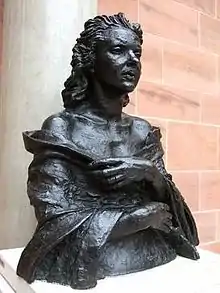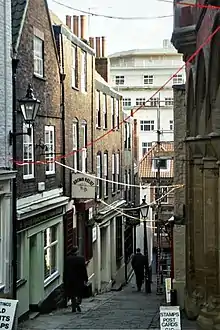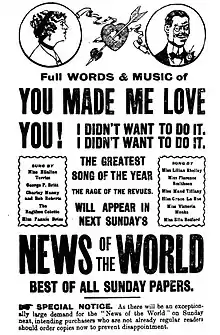Lilian Shelley
Lilian Shelley (born Lilian Milsom) (1892 - after 1933) was a popular music hall entertainer and later artists' model in London in the early 1900s known as "The Bug" or "The Pocket Edition".[1] She posed for Jacob Epstein and Augustus John. John's portrait of Shelley was described as one of the "star turns" in an exhibition Pictures of Women at the Wildenstein Galleries, London, in 1940.[2] He called her "Bill".



Early life
Lilian Shelley was born Lilian Milsom in a Bristol public house in 1892.[3] According to later newspaper reports she had to teach herself to read and write.[4] The 1901 British census records the family living at 2 Christmas Steps, Bristol, with Albert Milsom (aged 34) as the head of the household together with his wife Mary (aged 32), a son Albert (aged 8) and Lilian (aged 8).[5]
James Dickson Innes
She knew the painter James Dickson Innes, who came under the influence of Augustus John, and in 1911 Innes took Shelley to John's Welsh base at Penmachno. As far as is known, Innes did not paint Shelley, preferring landscapes, but he was such a poor figure painter that his subjects are not always identifiable. The fair-haired woman he did paint is most likely the model Euphemia Lamb.[6] Augustus John did paint Shelley however, in a black dress in a work shown at the Alpine Club in 1917, and she has been described as one of John's mistresses.[7]
Music hall career
Shelley was a successful musical hall performer dubbed as "Crazy Lilian Shelley. The Merry, Mad, Magnetic Comedienne."[8] She was known for "My Little Popsy-Wopsy", a popular Edwardian song, and "You Made Me Love You (I Didn't Want to Do It)" (1913) which had been popularised by Al Jolson. Shelley was represented by the Rolls-Darewski[9] agency and appeared in London and regional shows with performers from the same stable such as American violinist Jay Whidden and George Clarke ("London's leading Dude"). In 1913/14 she toured in the revue Step This Way which appeared in Birmingham, Sheffield and Scotland, and probably elsewhere, as one of the main acts mentioned in the billing.[8] She was one of the entertainers photographed by Walter Benington.[10]
Marriage
In 1914, Shelley married the artist John P. Flanagan in the Marylebone district of London, under her real name of Milsom.[11][12]
Bohemian life
Shelley was a contemporary of the other artists' models Betty May, Euphemia Lamb and Dolores, all of whom also posed for Epstein, and like Dolores she sang and danced at Madame Strindberg's The Cave of the Golden Calf (1912–1914).[13] One of her jobs at the Cave was to visit the Savoy Hotel each evening to feed Madame Strindberg's monkey.[14] According to Nina Hamnett, in 1914 Lilian Shelley and Betty May were the "principal supports" of the Crab Tree Club.[15] There also, she would sing "Popsy-Wopsy".[16]
She was a regular at the Café Royal where she was often seen in the company of the practical joker, Horace de Vere Cole, who maintained that a woman's nose was an indication of beauty and Shelley's could not be faulted.[17] Nina Hamnett described Shelley as "the craziest and most generous creature in the world", giving someone a piece of jewellery if they admired it.[18] M.J. Woddis described her appearance as "a Botticelli-looking person, with strangely cut black hair, which is adorned with a golden-embroidered head-band, a perfect model of an Egyptian goddess"[19] while John Quinn wrote to Jacob Epstein in 1915 that Shelley was "a beautiful thing ... red lips and hair as black as a Turk's, stunning figure, great sense of humour".[20] She posed for Jacob Kramer in a work now thought lost.[21]
Jacob Epstein
Jacob Epstein completed a head and a larger bust of Shelley. One was shown at the Grosvenor Gallery in Bond Street in 1916[22] and another at the Leicester Galleries in 1920. On one occasion, Shelley arrived at a gallery showing one of these works with a male friend who said to Epstein "Yes, I can see that you have depicted the vicious side of Lillian". Epstein answered that he thought the man knew Lilian better than he did. According to Epstein, the man was later "kicked to death in Cornwall by the miner father of a girl he had attempted to seduce."[13]
Mary Bryant
In 1923, William Collins published a possibly autobiographical novel, Mary Bryant, a girl of the people. A novel., by Shelley. It told the story of a girl born in a Bristol slum who is led by an "indefinable yearning" to seek a more fulfilling life in London and Paris. A review of the book noted its "unusual presentation of Bohemian life".[23]
Death
According to Virginia Nicholson, Shelley committed suicide.[24] She was evidently alive in 1934[7] but the exact date of her death is unknown.
Selected depictions of Lilian Shelley
- Head of Lilian Shelley. Jacob Epstein.
- Bust of Lilian Shelley. Jacob Epstein, bronze, 1920.
- Lilian Shelley in Black Dress. Augustus John. (Shown at the Alpine Club, 1917)
References
- May, Betty. (1929) Tiger Woman: My Story. (2014 reprint) London: Duckworth, p. 71. ISBN 978-0715648551
- "Wildenstein Galleries", The Times, 30 January 1940, p. 4.
- "England & Wales births 1837-2006 Transcription", findmypast. Retrieved 25 October 2014. (subscription required)
- "Tragic Fates Haunt Paths of Great Sculptor's Models", The Milwaukee Sentinel, 27 November 1932, p. 3.
- "1901 England, Wales & Scotland Census Transcription", findmypast. Retrieved 25 October 2014. (subscription required)
- Hoole, John. (1977) James Dickson Innes. Southampton: Southampton Art Gallery. Image captions 79 & 83.
- Virtue, John. (2001). Leonard and Reva Brooks: Artists in Exile in San Miguel de Allende. McGill-Queen's Press. pp. 40–42. ISBN 978-0-7735-2298-5.
- Advertising, Daily Record and Mail, 17 March 1914, p. 4. British Newspaper Archive. Retrieved 27 September 2014. (subscription required)
- The Stage Year Book 1916. London: The Stage.
- Irene Rooke. National Portrait Gallery. Retrieved 27 September 2014.
- "Epstein's Best" Daily Express, 6 February 1920, p. 6.
- "England & Wales marriages 1837-2008 Transcription", findmypast. Retrieved 25 October 2014. (subscription required)
- Epstein, Jacob. (1940) Let There Be Sculpture. New York: Putnam, pp. 99–100.
- Hamnett, Nina. (1932) Laughing Torso: Reminiscences of Nina Hamnett. New York: Ray Long & Richard R. Smith, p. 47.
- Hamnett, 1932, pp. 175–6.
- Pizzichini, Lilian (2010). The Blue Hour: A Portrait of Jean Rhys. London: Bloomsbury. p. 104. ISBN 978-1-4088-1307-2.
- Downer, Martyn (2011). The Sultan of Zanzibar: The Bizarre World and Spectacular Hoaxes of Horace De Vere Cole. London: Black Spring Press. p. 159. ISBN 9780948238468.
- Hamnett, 1932, p. 108.
- "The Café Royal in War Time" by M.J. Woddis in Colour, July 1915, p. 220. Quoted in Richard Cork (1985). Art Beyond the Gallery in Early 20th Century England. New Haven & London: Yale University Press. p. 109. ISBN 978-0-300-03236-9.
- John Quinn letter to Jacob Epstein, 7 August 1915, Quinn Collection, New York Public Library. Quoted in Michael Holroyd (1997) Augustus John: The New Biography. 2nd revised edition. London: Vintage, p. 378. ISBN 0099333015
- "A considerable work: Kramer in the east end", Bernard Brett, The Yorkshire Post, 17 October 1938, p. 6.
- "London Letter", Edward Storer, Bruno's Weekly, 1 April 1916, p. 586. Blue Mountain Project, Princeton University. Retrieved 26 September 2014.
- "The Library Table: Courage", Yorkshire Post and Leeds Intelligencer, 17 October 1923, p. 4. British Newspaper Archive. Retrieved 27 September 2014. (subscription required)
- Nicholson, Virginia. (2002). Among the Bohemians: Experiments in Living 1900–1939. London: Viking. p. 281. ISBN 0670889660.